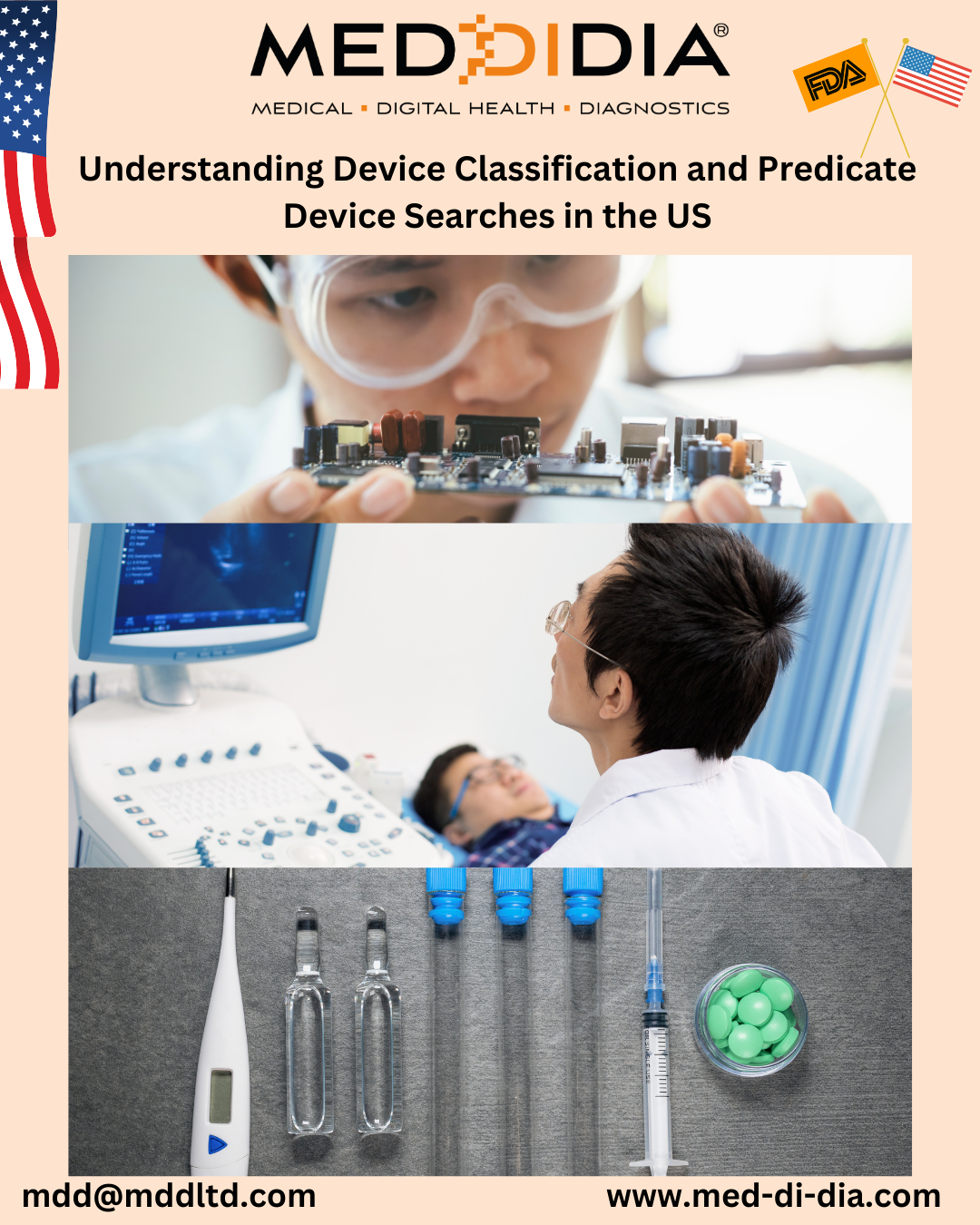Understanding Device Classification and Predicate Device Searches in the US
Launching a medical device in the United States requires navigating a complex regulatory environment governed by the U.S. Food and Drug Administration (FDA).
Two crucial aspects of this process are
- understanding device classification and
- conducting predicate device searches.
Let us understand more about these processes.
1. What is Device Classification?
The FDA classifies medical devices into three categories based on their risk level and the regulatory controls necessary to ensure safety and effectiveness:
- Class I: Low-risk devices that require minimal regulatory control. Most Class I devices are exempt from premarket notification (510(k)) but must comply with general controls, such as good manufacturing practices and proper labelling. Examples include tongue depressors and elastic bandages. FDA Class I Devices
- Class II: Moderate-risk devices that necessitate more regulatory controls to ensure safety and effectiveness. These devices typically require premarket notification (510(k)) to demonstrate substantial equivalence to a predicate device. Examples include infusion pumps and powered wheelchairs. FDA Class II Devices
- Class III: High-risk devices that are subject to the highest level of regulatory control. These devices generally require premarket approval (PMA) based on substantial scientific evidence of safety and effectiveness. Examples include implantable pacemakers and certain heart valves. FDA Class III Devices
2. How to Determine Your Device Classification
To determine the classification of your medical device, follow these steps:
- Identify the Device’s Intended Use and Indications for Use: Understand the device’s purpose and the conditions it is meant to diagnose, cure, mitigate, or treat.
- Review the FDA’s Device Classification Database: The FDA offers a searchable database to find device classifications and related information. This tool helps in determining the appropriate class for your device. FDA Device Classification Database
- Consult the FDA’s Classification Regulation List: This list details the classifications for various types of devices and can help you find the most relevant category. FDA Classification Regulation List
- Consider Consulting with Regulatory Experts: If you need additional clarity, consulting with experts can provide guidance and ensure compliance with FDA regulations.
3. What is a Predicate Device?
A predicate device is a legally marketed device that serves as a basis to demonstrate that a new device is substantially equivalent. This concept is critical to the 510(k) premarket notification process.
- Substantial Equivalence: To gain FDA clearance through the 510(k) process, your device must be shown to be substantially equivalent to a predicate device in terms of intended use, technological characteristics, and performance. FDA 510(k) Premarket Notification
- Predicate Device Criteria: The predicate device must be legally marketed in the US, meaning it should have been cleared by the FDA or approved through a similar process.
4. How to Conduct a Predicate Device Search
- Access the FDA’s 510(k) Database: Use the FDA’s 510(k) database to search for predicate devices by device name, product code, or other criteria. This is essential for finding devices similar to yours. FDA 510(k) Database
- Review 510(k) Summary Reports: These reports provide information about devices cleared through the 510(k) process, including their intended use and technological characteristics.
- Analyse Similar Devices: Look for devices with similar indications for use and technological features to ensure substantial equivalence.
- Evaluate Device Modifications: If your device includes modifications or innovations, compare these changes with the predicate devices to assess their impact on substantial equivalence.
- Consult with Regulatory Consultants: Consulting experts can help identify appropriate predicate devices for complex cases or additional support and ensure that your 510(k) submission meets all requirements.
5. Preparing for the 510(k) Submission
Once you have identified predicate device(s) and confirmed substantial equivalence, you need to prepare your 510(k) submission. This involves:
- Preparing a Detailed Device Description: Include information about the device’s design, components, and technological characteristics.
- Providing Performance Data: Submit data demonstrating that your device performs as intended and is as safe and effective as the predicate device.
- Labelling and Instructions for Use: Ensure your device labelling complies with FDA requirements and includes clear instructions for use. FDA Labelling Requirements
- Submitting the 510(k) Application: Complete the 510(k) application form, including all required documentation, and submit it to the FDA for review. [eSTAR]
6. Key Considerations and Challenges
- Device Classification Changes: Regulatory requirements and classifications can evolve. Regularly review the FDA’s guidelines and updates to stay compliant.
- Complexity of Predicate Devices: Identifying appropriate predicate devices can be challenging, especially for novel or modified devices. Consulting with experts can help navigate these challenges.
- Time and Cost: The 510(k) process can be time-consuming and costly. Careful planning and ensuring all required information is accurate can help mitigate delays and additional expenses.
When embarking on the journey of device classification and predicate device searches for FDA submissions, it's crucial to approach the process with a thorough understanding of regulatory requirements and strategic planning. Navigating the complexities of the FDA’s classification system and identifying the right predicate devices can be challenging and time-consuming. This is where Med-Di-Dia proves to be an invaluable partner. Our expertise in FDA submissions ensures that you accurately determine your device’s classification, conduct comprehensive predicate device searches, and streamline your submission process. With Med-Di-Dia's support, you can confidently manage regulatory compliance, reduce potential pitfalls, and enhance your chances of a successful market entry. Reach out to us to leverage our specialised knowledge and experience in FDA regulations for a smoother and more efficient approval journey.
Reach out to our experts by sending an email to mdd@mddltd.com or by submitting a web form - https://med-di-dia.com/contact.php








